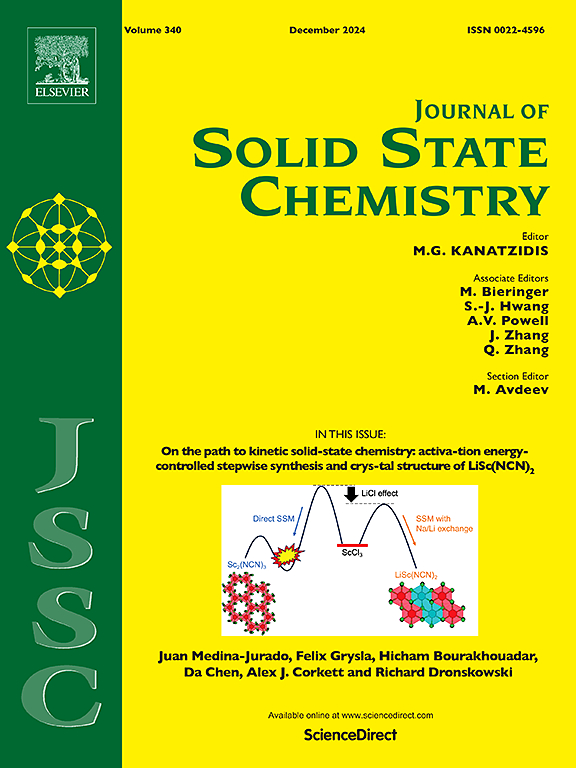Innovative structural and optical insights into synthesized BaTi(1-2x)SbxCrx(PO4)2 (0 ≤ x ≤ 0.5) yavapaiite phases
IF 3.2
3区 化学
Q2 CHEMISTRY, INORGANIC & NUCLEAR
引用次数: 0
Abstract
A series of yavapaiite-type phosphates BaTi(1-2x)SbxCrx(PO4)2 (0≤x ≤ 0.5), was synthesized via solid-state reactions across divers fractions x, and studied by X-ray diffraction, Infrared, Raman UV–visible, and color (CIE-L∗a∗b∗) analyses. These compounds crystallize too in the monoclinic space group C2/m (Z = 2), with yavapaiite structure type and comparable units’ cell parameters. The structure type consists of layers, arranged parallel to (a, b) plane, and formed by corner-connected Ti(Sb/Cr)O6 octahedra and PO43− tetrahedra groups. Rietveld refinements showed that the substitution of Ti4+ by Sb5+ and Cr3+ cations did not change the yavapaiite crystal structure symmetry, lattice parameters, bond lengths, and angles in studied (0≤x ≤ 0.5) compositions. Specifically, the parameters increase very slightly as x increased from 0 to 0.5 without changing the yavapaiite structure-type. The SEM-EDX high-resolution images showed the formation of divers agglomerated particles with grain boundary and different sizes, and confirmed the presence of expected elements for all studied compositions (0 ≤ x ≤ 0.5). Hirshfeld surface and Fringplots analyses made on BaTi(PO4)2 crystal structure (x = 0), highlited that Ba⋯O/O⋯Ba (39.5 %) and O⋯O (32.1 %) are the important intercontacts contributors in the BaTi(PO4)2 crystal packing. Infrared and Raman spectra recorded at room temperature revealed characteristic bands of the PO43− tetrahedra groups, with slight changes in frequencies positions and intensities with varying the x fractions. The UV–visible absorption spectra showed the effect of Sb/Cr substitution on the optical band gap. Direct band gap values are estimated at 3.62 eV for (x = 0) and around 2.64 eV for (x = 0.1–0.5), indicating a semi-conducting behavior of the substituted materials in the studied composition range. The partial substitution of Ti4+ with Sb5+/Cr3+ affects the optical properties of BaTi(1-2x)SbxCrx(PO4)2 (0 ≤ x ≤ 0.5) in the way that modifying the Sb/Cr content can remarkably reduce the optical band gap.

求助全文
约1分钟内获得全文
求助全文
来源期刊

Journal of Solid State Chemistry
化学-无机化学与核化学
CiteScore
6.00
自引率
9.10%
发文量
848
审稿时长
25 days
期刊介绍:
Covering major developments in the field of solid state chemistry and related areas such as ceramics and amorphous materials, the Journal of Solid State Chemistry features studies of chemical, structural, thermodynamic, electronic, magnetic, and optical properties and processes in solids.
 求助内容:
求助内容: 应助结果提醒方式:
应助结果提醒方式:


